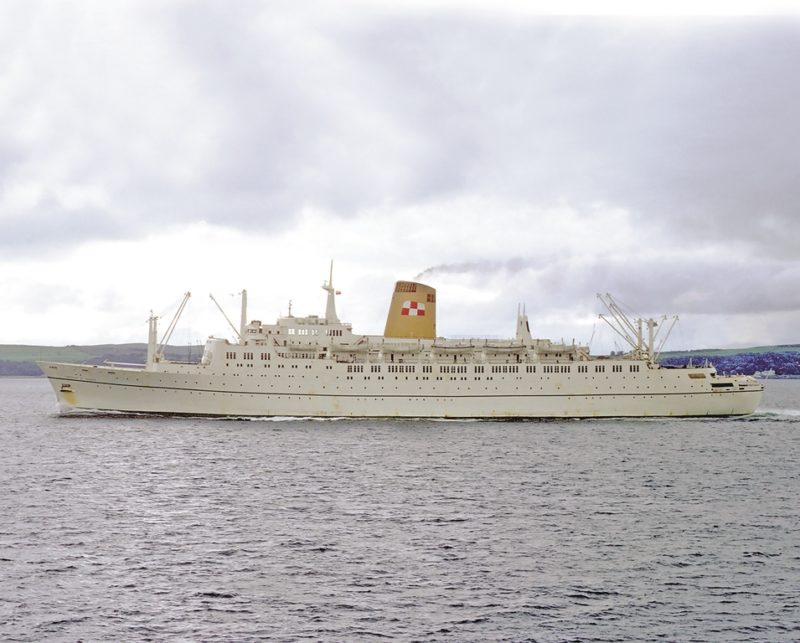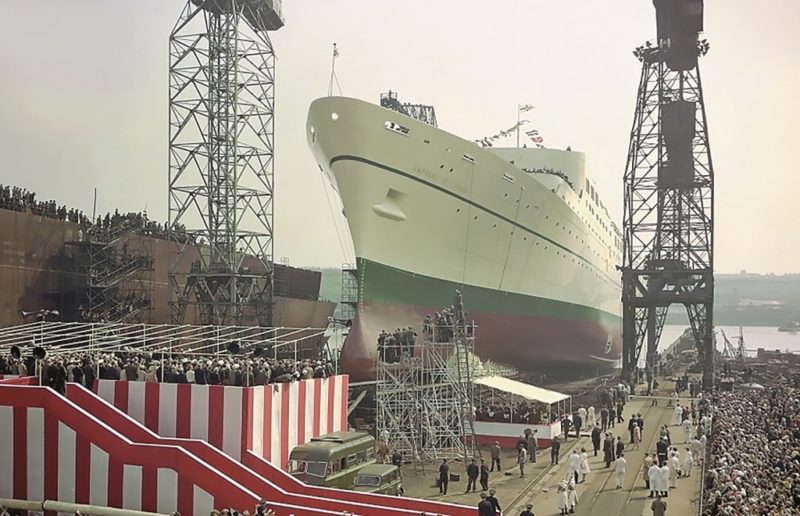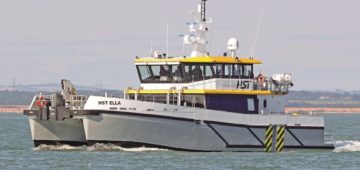
The World’s Most Complete Transportation System’. In this age of advertising hubris it is easy to dismiss this marketing slogan, as yet another example of commercial hyperbole. Yet there was much truth in the statement. Canadian Pacific truly spanned the globe. The first White Empresses with their elegant clipper bows (complete with bowsprits) and counter sterns inaugurated a trans-Pacific service in 1891. Transatlantic crossings started in 1904 with the acquisition of Beaver Line, Canadian Pacific introducing its first new builds years later. The Atlantic and Pacific oceans were linked, from Montréal to Port Moody, by the company’s famed railway system, and supplemented by a portfolio of magnificent hotels across the Dominion.
Canadian Pacific’s zenith was in the inter-war years. In 1931 they introduced the magnificent Empress of Britain, a vessel of 42,348grt that eclipsed any rival tonnage on the Canadian route and the majority of competitors sailing to New York. Famed for her annual around the world cruises, with two of her four propellers and shafts removed and a reduced complement of millionaires on board, she forsook the ice bound St. Lawrence and steamed at a leisurely pace encircling the globe. The Second World War decimated the Canadian Pacific fleet. Losses included Empress of Asia, Empress of Canada, Duchess of York and Duchess of Atholl but most tragically the beloved Empress of Britain. Abandoning the trans-Pacific service, the company introduced modest cargo liners to supplement a post-war transatlantic passenger service. This was headed by Empress of Scotland, originally the 1931 built Empress of Japan, Empress of France and the hastily purchased French Liner De Grasse, which was renamed Empress of Australia.
Investment in new tonnage was a priority and initial orders were placed with Fairfield Shipbuilding & Engineering Ltd. at Govan and Vickers-Armstrong on the Tyne, for two 25,500grt sisters. Completed in 1956 and 1957 respectively, the Empress of Britain and Empress of England regained Canadian Pacific’s pre-eminent role in the service to the St. Lawrence. A great deal of research had gone into their internal and external design, creating very modern vessels to compete with Cunard’s Saxonia quartet. Nevertheless, after appraising the performance of the new Empresses and with the timely sale of veteran Empress of Scotland, Canadian Pacific decided to order a new, larger flagship. She would prove to be their last.

To build this new vessel they turned once again to Vickers-Armstrong, where the first keel plate was laid on the slipway on 27th January 1959. Sixteen months later, on a bright May day, the flag-bedecked hull was named Empress of Canada by Mrs John Diefenbaker, wife of the Canadian Prime Minister, and slid into the Tyne to the cheers of thousands spectators bordering the slipway and lining the opposite bank.
The ship that emerged over the following seven months was a slightly larger, updated version of her predecessors. Those attending the launch could not help but notice the bulbous forefoot to the bow, a company first designed to optimise water flow, reduce fuel consumption and increase speed. The sculpted cruiser stern with integral anchor housing was retained from the earlier ships but the eagle eyed would also have noted stabilizer housings on each flank, again a company first, which could reduce rolling by a third. Welding was used extensively throughout and plating at the forepeak and along the flanks around the waterline, was specially ice strengthened. Although not immediately obvious, considerable time was also spent optimising the new vessel’s rudder design, to improve manoeuvrability in the confines of the St. Lawrence. In February 1961 the structurally complete liner was manoeuvred along the Tyne to Swan Hunter & Wigham Richardson’s yard at Wallsend for dry docking. She presented a very handsome and sturdy profile, more harmonious than her predecessors primarily thanks to the observation lounges and covered games area located aft of the bridge and the larger tapered funnel, featuring grills at both front and rear to create an updraft and thereby take smoke clear of the aft decks. A subtle touch was incorporating curves to the checkerboard funnel logo to mirror those on the top of the stack. The single aluminium mast was of a thicker contemporary design with unique grill like yard arms. Aft of the funnel were two, small, athwart ship masts, similar in design and function to those on the France, then building at St Nazaire. Echoing the funnels frontal rake these added to the ship’s overall balance, whilst also providing a functional exhaust. The rear decks were tiered towards the stern and lifeboats housed in a conventional position, on davits above the narrow outdoor promenades. If there could be any criticism of the silhouette, it was the preponderance of cargo handling kingposts and the jumbled configuration of decks below the bridge. Cargo capacity was significant, with almost 280,000 cubic feet for a diverse range of products from grains to machinery, and including over 16,000 cubic feet for refrigerated goods. The four holds were split evenly fore and aft and serviced by three pairs of kingposts. One pair were incongruously located straddling the bridge, where they dominated the forward end. When Carnival removed them along with the aft pair at a later refit it certainly enhanced the ship’s looks.

The Empress of Canada’s interior design and décor was co-ordinated by the Glasgow architect J. Patrick McBride and the London-based consultant Paul Gell. Considering her duality of purpose, summertime two class liner and wintertime single class cruise ship, the intention was to create rooms to meet both roles with no clearly defined class distinction. Indeed public rooms were not designated First or Tourist class, instead all were given Canadian themed names and décor with the exception of the Mayfair and Windsor Lounges (respectively the main first and tourist class public spaces in transatlantic service). Pale wood panelling predominated whilst the largest public room on board, the two deck high Canada Room ballroom, was a light, airy modernistic space, with a golden colour scheme and curtaining and a gallery overlooking the dance floor. Recessed lighting in the squared dome could be dimmed to match the musical mood. Like the large cinema, it was available to all passengers irrespective of class on transatlantic service.
Sign-up today to read the full article!
Simply click below to sign-up and read the full article, as well as many others, instantly!






Comments
Sorry, comments are closed for this item